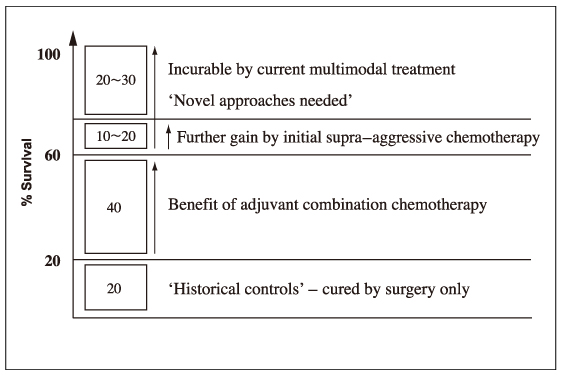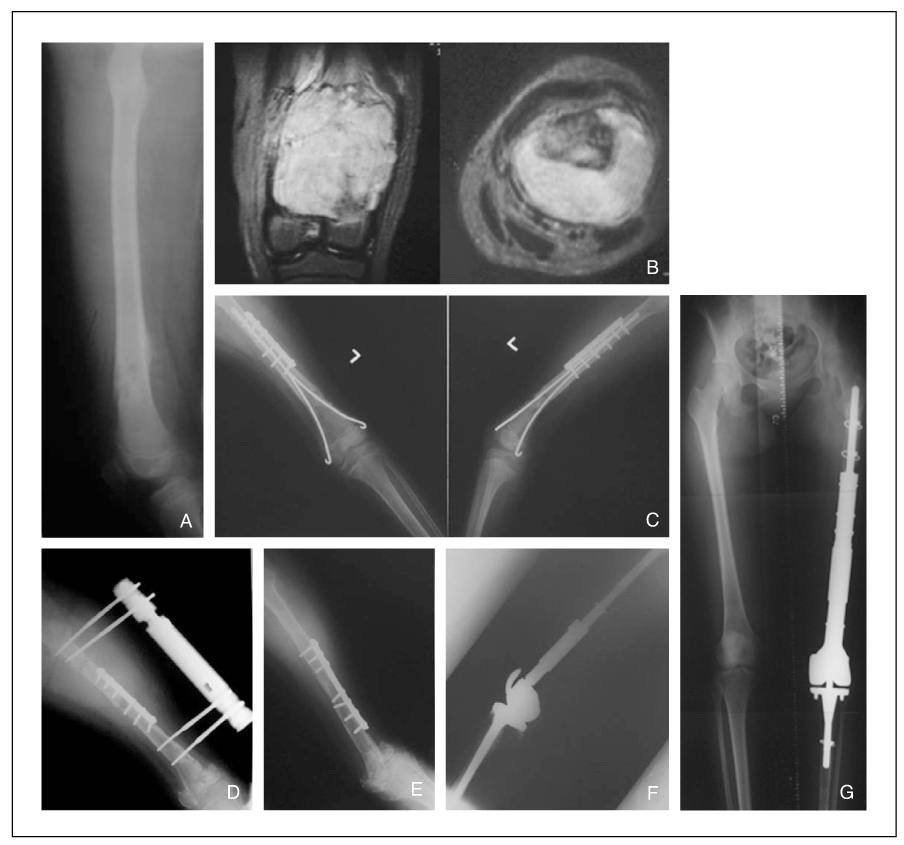J Korean Med Assoc.
2006 Dec;49(12):1119-1125. 10.5124/jkma.2006.49.12.1119.
Current Concept and New Strategy in Osteosarcoma Management
- Affiliations
-
- 1Department of Orthopaedic Surgery, Kosin University College of Medicine, Korea. jdkim@ns.kosinmed.or.kr
- KMID: 2184742
- DOI: http://doi.org/10.5124/jkma.2006.49.12.1119
Abstract
- Major progress in the management of osteosarcoma has been made due to advances in diagnostic imaging, operative technique, and chemotherapy, resulting in an improved survival. However, 20~30% of patients with osteosarcoma still develop distant metastases despite combined modality treatment. Currently various experimental efforts are being proposed to the future new strategy include drug resistance, suppression of metastasis mechanism, and targeted therapy to convert the incurable rate of 20~30% upto complete cure rate.
Keyword
Figure
Reference
-
1. Winkler K, Beron G, Delling G, Heise U, Kabisch H, Gerein V, et al. Neoadjuvant chemotherapy of osteosarcoma: results of a randomized cooperative trial (COSS-82) with salvage chemotherapy based on histological tumor response. J Clin Oncol. 1988. 6:329–337.
Article2. Meyers PA, Gorlick R, Heller G, Casper E, Lane J, Healey JH, et al. Intensification of preoperative chemotherapy for osteogenic sarcoma: results of the Memorial Sloan-Kettering (T12) protocol. J Clin Oncol. 1998. 16:2452–2458.
Article3. Goorin AM, Schwartzentruber DJ, Devidas M, Gebhardt MC, Ayala AG, Grier HE, et al. Pediatric Oncology Group. Presurgical chemotherapy compared with immediate surgery and adjuvant chemotherapy for nonmetastatic osteosarcoma: Pediatric Oncology Group Study POG-8651. J Clin Oncol. 2003. 21:4662–4663.
Article4. Berend KR, Pietrobon R, Moore JJO, Dibernardo L, Harrelson JM, Scully SP. Adjuvant chemotherapy for osteosarcoma may not increase survival after neoadjuvant chemotherapy and surgical resection. J Surg Oncol. 2001. 78:162–170.
Article5. Fuchs N, Bielack SS, Epler D, Bieling P, Delling G, Winkler K, et al. Long-term results of the co-operative German-Austrian-Swiss osteosarcoma study group's protocol COSS-86 of intensive multidrug chemotherapy and surgery for osteosarcoma of the limbs. Ann Oncol. 1998. 9:893–899.
Article6. Bacci G, Ferrari S, Longhi A, Picci P, Mercuri M, Forni C, et al. High dose ifosfamide in combination with high dose methotrexate, adriamycin and cisplatin in the neoadjuvant treatment of extremity osteosarcoma: preliminary results of an Italian Sarcoma Group/Scandinavian Sarcoma Group pilot study. J Chemother. 2002. 14:198–206.
Article7. Meyers PA, Schwartz CL, Krailo M, Kleinerman ES, Betcher D, Grier H, et al. Osteosarcoma: a randomized, prospective trial of the addition of ifosfamide and/or muramyl tripeptide to cisplatin, doxorubicin, and high-dose methotrexate. J Clin Oncol. 2005. 23:2004–2011.
Article8. Smith MA, Ungerleider RS, Horowitz ME, Simon R. Influence of doxorubicin dose intensity on response and outcome for patients with osteogenic sarcoma and Ewing's sarcoma. J Natl Cancer Inst. 1991. 83:1460–1470.
Article9. Ferrari S, Figus E, Cagnano R, Iantorno D, Bacci G. The role of corrected QT interval in the cardiologic follow-up of young patients treated with Adriamycin. J Chemother. 1996. 8:232–236.
Article10. Delepine N, Delepine G, Bacci G, Rosen G, Desbois JC. Influence of methotrexate dose intensity on outcome of patients with high grade osteogenic osteosarcoma. Analysis of the literature. Cancer. 1996. 78:2127–2135.
Article11. Bacci G, Forni C, Ferrari S, Longhi A, Bertoni F, Versari M, et al. Neoadjuvant chemotherapy for osteosarcoma of the extremity: intensification of preoperative treatment does not increase the rate of good histologic response to the primary tumor or improve the final outcome. J Pediatr Hematol Oncol. 2003. 25:845–853.12. Lewis IJ, Weeden S, Machin D, Stark D, Craft AW. European Osteosarcoma Intergroup. Received dose and dose-intensity of chemotherapy and outcome in nonmetastatic extremity osteosarcoma. J Clin Oncol. 2000. 18:4028–4037.
Article13. Sauerbrey A, Bielack S, Kempf-Bielack B, Zoubek A, Paulussen M, Zintl F. High-dose chemotherapy (HDC) and autologous hematopoietic stem cell transplantation (ASCT) as salvage therapy for relapsed osteosarcoma. Bone Marrow Transplant. 2001. 27:933–937.
Article14. Arpaci F, Ataergin S, Ozet A, Erler K, Basbozkurt M, Kuzhan O, et al. The feasibility of neoadjuvant high-dose chemotherapy and autologous peripheral blood stem cell transplantation in patients with nonmetastatic high grade localized osteosarcoma: results of a phase II study. Cancer. 2005. 104:1058–1065.
Article15. Gebhardt MC. Relevance of MDR in osteosarcoma. 1996. In : Second Osteosarcoma Research Conference; November 19 - 22; Bologna, Italy. 93–95.16. Pakos EE, Ioannidis JP. The association of P-glycoprotein with response to chemotherapy and clinical outcome in patients with osteosarcoma. A meta-analysis. Cancer. 2003. 98:581–589.
Article17. Moe L, Boysen M, Aas M, Lonaas L, Gamlem H, Bruland OS. Maxillectomy and targeted radionuclide therapy with 153Sm-EDTMP in a recurrent canine osteosarcoma. J Small Anim Pract. 1996. 37:241–246.
Article




